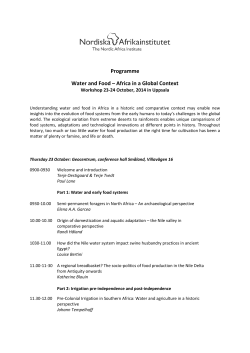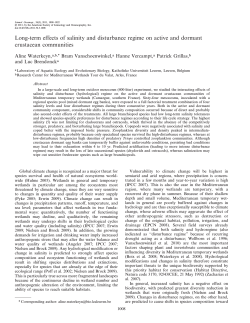
Document 439452
Salinization in semiarid irrigated regions of Argentina Dr. E.P. Querner Contents • Salinization process • Salinization in Argentina • Hydrological modelling using SIMGRO • Model application: Mendoza region • Conclusions Hydrological processes at the soil surface Why does soils get saline Vineyard affected by salts no problems Salinised soils in the world Region Area (mln ha) Africa 69.5 Near and Middle East 53.1 Latin America 59.4 North America 16.0 Asia and Far East Australia 19.5 84.7 Europe 20.7 _________________________________ Irrigated area world wide 275.0 Salinity Salinity is measured in electric conductivity of a saturated extract of the soil sample expressed as: EC – Electrical Conductivity (dS/m) (deci Siemens per meter) Fresh water: EC < 0.5 dS/m Saline soil: EC 4 – 8 often results in yield depression (less crop production) Some crops like barley are salt tolerant (EC < 12=16) Salinity movement in the soil Salinization (salt accumulation) can take place both at relatively shallow and deep groundwater tables. How to estimate salinity (1) • Make a water balance of the water flows Assign an EC to each flow How to estimate salinity (2) Make use of a hydrological model EC is regarded as a conservative matter (as a tracer) Requirements for a modelling approach • Physically based ( a white box ) Not a conceptual or lumped model ( a grey box ) • Simulate processes as accurately as possible • Not too much input data • Modular set=up • Applicable practical problems and hydrological research Hydrological model: model? SWAT (not yet) or SIMGRO (yes) For irrigated systems Sub region Sub region border border Soil use Surface drainage Drainage system Root zone Irrigation system Capillary rise or deep percolation Sub surface drainage Prescribed flux or level 1st aquifer Aquitard (less permeable layer) 2nd aquifer Hydrological base Discretisation Model area Subcatchment Nodes Subcatchments: Surface water Nodes: Unsaturated zone Groundwater Sub=soil salinity transport (SIMGRO model) Interaction surface water = groundwater SIMGRO/AlterrAqua GIS=application: Presentation of results: • Groundwater levels and river flows AlterrAqua • Evapotranspiration (potential and actual) Digital input data • Etc. Results Presentation of input data Calculation with SIMGRO Example input data Watercourses Culverts Weirs Subcatchments Land-use DTM Sewer catchments Topographic. data Some case studies carried out with Simgro model to support policy making Country Name Brazil Pantanal=Taquari Lithuania Dovine Basin Poland Biebrza wetland South Africa Limpopo and Letaba Description Management tool for analysis of measures to ensure a sustainable situation of this wetland Determine the impact of climate change and land use changes To support the design of an integrated restoration and management plan Small holder farming. Effect of upstream water use on down= stream nature areas Argentina Irrigated area in Argentina 1.35 mln ha (4.1% of country) 20% of irrigated land is in Prov. of Mendoza 70% irrigated with surface water 21% sprinkler irrigation 9% drip irrigation Mendoza Province MENDOZA RIVER IRRIGATED AREA Irrigation water is allocated according to area with water rights Problems - water shortage (dry years) - supplementary groundwater use - over-irrigation (wet years) - high water tables - soil salinization - crop productivity reduction - environmental degradation Mendoza River Lower Tunuyan Upper Tunuyan Irrigation network Sometimes quite complex Irrigation by flooding Irrigation of crops MENDOZA RIVER BASIN Salinity modelling Andes Saline soils Potrerillos new reservoir Mendoza city Mendoza irrigated system Mendoza river Question to be addressed by INA=CRA 1. What will be the consequences in the irrigated area of Mendoza River because of the construction of Portrerillos dam in the Andes mountains 2. Will the salinity level increase Consequence of building the dam 1. Sediments are trapped in the dam 2. The irrigation water will be clear (no sediments) 3. Unlined canals will have less sediments on the bottom, thus the canals are more permeable and water can percolate to the groundwater 4. Groundwater levels become higher 5. More capillary rise 6. Consequence higher salinity Objectives of study To analyse basin behaviour because of construction Potrerillos storage dam: • Hydrology (surface water and groundwater ) • Salt balance (soil & water) • SIMGRO model calibration in the area irrigated by Mendoza river • Performance indicators are used to quantify & qualify the irrigation and drainage water use • Give present situation and after dam constructed Construction Porterillos dam Portrerillos dam Before and after construction of the dam Before: After: Irrigation canals Tertiary and drainage canal Irrigated area of Mendoza River Image land=use Areas irrigated by Mendoza and Tunuyan River False color (red means irrigated land) Zones Modelling area Modelling area was based on the irrigated areas (area 3400 km2) Irrigation and drainage canals plus natural streams N References Irrigation System Superficial Drainage System Drainage System River Natural Stream Projet Area SIMGRO model Subregiones Modelo Simgro • • • • • Nodes: 3685 Distance: 1000 m * 1000 m Elements: 6986 Subregions: 124 3 aquifers and 2 aquitards N Riego y Drenaje Río Mendoza Río Tunuyán Poligonos Subrregiones Modelo Simgro Canales 1º Tunuyán Drenes Tunuyán Land use: • grapes & fruit trees • olives • summer vegetables • winter vegetables • grass • fallow • urban area 1:750000 10 0 10 20 Kilometers Finite element network and the irrigation canals Network has 3685 nodal points; approx. 1000 m apart Groundwater pumping wells in the area Soil type: mean basic infiltration 1.3 – 7.3 mm.h-1 N # # # ## # # ## # # ## # ## # # # # # # ## # # ## # # ## # ## # # # ## ## # # # ## # # # # # # # ## # # ## ## # # # # # # # # # # # # # # # # # # ## # ## # # # # # # # # # # # # ## # # # # # # # # # # # # # # ## # # # # # # # # # # # # # ## # # # # # # # # # # # # # # # # # ## # # # # # ## # # # # # # # # # # # # # # # # # # # # # # ## # # ## # # # # # # # # # # # # # # # # # # # # # # # # # ## ## # # # # # # # ## # # # # # # # # # # # # # # # # # # # ## # ## # # ## # # # # # # # # ## # # # # # # # # # ## # # # # # # ## # # ## ## # # # # # ### ## # # ## # # ## # # # # # # # # # ##### # # # # # # # # # # # # #### # # # # # # # ## # ## # # # ## # # # # # # # # # # # # # # # # # # # # # # # # # # # # ## # # # # ## # # # # # # # # # # # # # # # # # # # ## ## # ## # # # # # # ## # # # # # # # # # # # # # # ## # # # ## # # # # # # # # # # # # # # # # # # # # # # # # # # # # # # # # # # # # # # # # # # # # # # # # # # # # # ## # # # # # ## # # # # # ## # # # ## # # # # # # # # # ## # # # # ### # # # # # # # # References # Well Network Projet Area # # # # # SERIES DE SUELOS I - Compuertas Maipú II - Ciudad - Agrelo - Rodeo III - Corralitos - Barcala IV - El Sauce - Jocolí V - Lavalle VI - Tres Porteñas Performance indicators • To evaluate changes and feasibility of mitigation measures • Performance indicators should include water delivery, water use efficiency, maintenance, irrigation sustainability, environmental aspects, socio=economics and management. Performance indicators used • Relative evapotranspiration (RET): ratio between actual and potential evapotranspiration. It reflects to what an extent the potential evapotranspiration is met, and influences crop yield. • Depleted fraction (DF): relates water balance parameters for an irrigated area with each other in such a way that the manager knows the rate of change of groundwater level. DF = ETactual P + Vc ETactual : actual evapotranspiration by irrigated crops P Vc : precipitation : volume of irrigation by surface= and groundwater MODEL CALIBRATION The model was calibrated using groundwater levels, evapotranspiration, and salinity for 94/95 growing season. ET (m m /m onth) 140 120 100 80 60 40 20 0 sep oct nov Grape measured Ene-94 Abr-94 Jul-94 dec jan feb mar apr Grape simulated subregion 403 Oct-94 Feb-95 May-95 0.0 GW depth (m) -0.5 -1.0 -1.5 -2.0 -2.5 Tim e (m onth) 2391 measured 2391 simulated Groundwater depth at node 2391 7.0 ECe (dS.m -1) 6.0 5.0 4.0 3.0 2.0 1.0 0.0 May/90 May/91 May/92 May/93 cultivated measured max grape simulated May/94 May/95 cultivated measured min Simulated and measured soil electrical conductivity (salinity) at grape root zone subregion 408 (growing season 90-95) 9.0 8.0 ECe (dS.m-1) 7.0 6.0 5.0 4.0 3.0 2.0 1.0 May/90 May/91 cultivated measured max olive simulated winter vegetables simulated grape simulated May/92 May/93 May/94 cultivated measured min summer vegetables simulated grass simulated May/95 Time (month) Simulated and measured soil electrical conductivity (salinity) at root zone in different irrigated crops (growing season 90-95). RESULTS OF PERFORMANCE INDICATORS 1.0 0.9 0.8 Relative ET 0.7 0.6 0.5 0.4 0.3 0.2 0.1 0.0 May-90 Nov-90 May-91 Nov-91 May-92 Nov-92 May-93 Nov-93 May-94 Nov-94 May-95 agricultural technologies Relative evapotranspiration (RET) of agricultural technologies y = -0.2371x + 0.1418 Change of groundwater table (m/month) 0.40 0.30 0.20 0.10 0.00 0 0.1 0.2 0.3 0.4 0.5 0.6 0.7 0.8 0.9 1 1.1 -0.10 -0.20 Depleted fraction Rate of change of groundwater table as a function of depleted fraction SCENARIO ANALYSIS S0: present situation - S1: new scenario (more infiltration from the river bed and irrigation canals) 7.0 ECe (dS.m-1) 6.0 5.0 4.0 3.0 2.0 1.0 0.0 May/90 May/91 measured max May/92 May/93 measured min May/94 S-1 SCENARIO ANALYSIS Rel. evapotranspiration of agricultural land S0: present situation and S1: new scenario May/95 S-0 Conclusions and recommendations SIMGRO can be used in situations where changing conditions affect the hydrological system Irrigation practices can be simulated for a number of years with changing meteorological conditions and irrigation depths The increase of infiltration losses in the riverbed and canals will result in a rise of the groundwater table In the lower part of the basin a significant increment in salinity can be expected Future modelling must reveal an improved water distribution scheme using the performance indicators as a reference
© Copyright 2025













